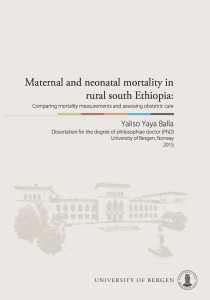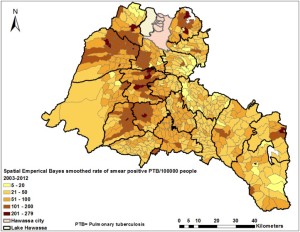Recently, Yaliso Yaya, PhD candidate at The Centre for International Health wrote the following post as part of the The Maternal Health Task Force series Translating Research into Practice Series.

Motorcycle ambulances have been useful for transporting mothers with complications to health facilities. The message in Amharic reads “A mother should not die while giving life.” (Photo: Demissew Mitiku).
Unfortunately, there is still limited information to oversee maternal and newborn mortality interventions in low-income countries. Developing countries lack vital registrations that are present in high-income countries. Because of the shortage of such essential information, translating policy into action and monitoring programmes to reduce maternal and neonatal deaths is difficult.
The new Sustainable Development Goals divide countries into three groups where the maternal mortality ratio (MMR) is greater than 400, between 100 and 400, and less than 100 based on the ratio in 2010. Such a grouping is necessary because different ratios may determine different intervention strategies. Unfortunately, for many countries there is a controversy over the level of the MMR. If we use Ethiopia as an example, a UN estimate of MMR in 2010 is 350 per 100,000 live births, whereas the DHS estimated it to be 676 for the same year.
As a follow-up to our paper, Maternal and Neonatal Mortality in South-West Ethiopia: Estimates and Socio-Economic Inequality, we developed, validated, and used community based birth registration in a population of about half a million people in four woredas, or districts, in rural southern Ethiopia. We aimed to estimate maternal mortality rates and to monitor progress in reducing deaths. The most important lesson we learnt, that may be applicable in similar settings in Ethiopia and in Africa, is that it is possible to obtain high-coverage birth registration and measure maternal mortality in rural communities with trained community health workers.
In southern Ethiopia, the MMR was high and most births and maternal deaths occurred at home. The MMR was about 500 per 100,000 live births in 2010, and data from 2014 show that this ratio may have been reduced by about 60%.
We also registered that when women’s access to comprehensive and basic obstetric services improves, a birth registration system can document important societal changes:
- Significantly increased institutional delivery rates
- Decreased use of traditional birth attendants
- More than half of women who deliver attend three or more antenatal care visits
In our experience, it is possible to register most births in rural Ethiopian communities using the health extension workers. However, we advise that a birth registry should be expanded to include registration of pregnancies as well as pregnancy outcomes. Such a system could provide the community health workers with a new tool to actively follow up pregnant women and ensure proper antenatal controls and referrals to institutions. It could also help in monitoring neonatal heath and be a tool to provide essential services to women in the weeks after birth.






